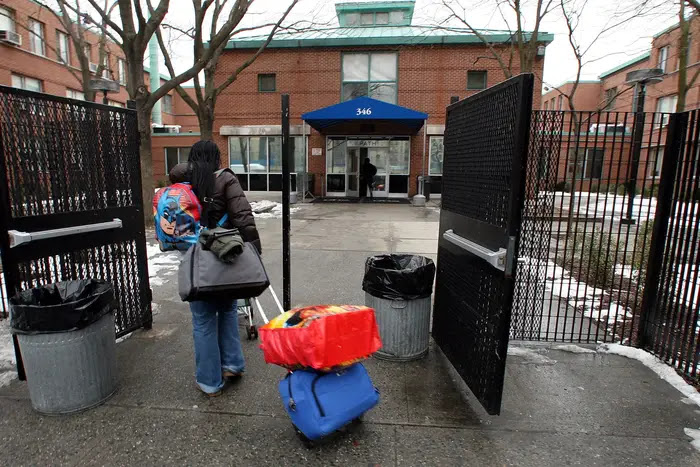~~ recommended by emil karpo ~~



The Contentious History Behind New York City’s Right to Shelter
New York State’s high court has yet to define the scope of the right to shelter, which comes from a Depression-era amendment to the state constitution.
In response to an influx of asylum seekers to New York City, the city this month asked a court to suspend its obligation to provide shelter to those who need it, maintaining that “extraordinary circumstances” justify a temporary lifting of the city’s right-to-shelter mandate. Housing advocates characterized the move as a “cruel effort to gut” protections for homeless people.
At the center of this crisis stands New York City’s unique right to shelter. Based on a Depression-era state constitutional amendment, the right has been defined through a series of hard-fought lawsuits. But the state’s highest court has yet to weigh in on the scope of the right. As New York City’s homeless population swells, a look at the long, winding history of its right-to-shelter mandate casts light on coming legal battles over what constitutional responsibility the city has to house those in need.
The right to shelter arose from a 1979 case, Callahan v. Carey, a class action on behalf of all homeless men in New York City. Attorney Robert Hayes — who went on to cofound Coalition for the Homeless — argued that the New York Constitution obligated the city to provide lodging to the plaintiffs. In making this argument, he pointed to Article 17, Section 1, of the state constitution, which provides that “the aid, care and support of the needy are public concerns and shall be provided by the state . . . in such manner and by such means, as the legislature may from time to time determine.” Hayes honed in on the first half of the text. “In our presentation before the judge,” he later said in an interview, “we simply argued that ‘shall’ means ‘shall.’”
A state trial judge agreed, holding that the plaintiffs were “entitled to board and lodging.” The city thereafter entered into a consent decree that required it to “provide shelter and board to each homeless man” who needs it.
The provision at the center of Callahan was one of several social welfare amendments proposed by a constitutional convention in 1938 — nearly a decade into the Great Depression — and later ratified by voters in a statewide referendum. New York City Mayor Fiorello La Guardia and other progressives wanted to create an affirmative state duty to care for its needy population. Edward Corsi, the chair of the committee responsible for drafting Article 17, considered the amendment a “charter of human protection for the underprivileged, the destitute and the handicapped.” The provision, he told the convention’s delegates, sought “to remove from the area of constitutional doubt the responsibility of the State to those who must look to society for the bare necessities of life.”
The amendment also served to safeguard from potential judicial scrutiny the state’s power to help destitute people. A series of rulings striking down social measures during the industrial era had convinced those attending the convention, many of whom were jurists and lawyers, “to remove all doubt as to the power of the Legislature to authorize relief for those in need” in the newly drawn constitution.
Callahan and the resulting consent decree served as the foundation for extending shelter services to homeless women (Eldredge v. Koch) and families (McCain v. Koch) in New York City. But even as the scope of the right to shelter has grown bigger and more complex, no court has issued a comprehensive and conclusive appraisal of Article 17. Instead, courts have grounded their extensions of the right in equal protection or in the consent decree itself.
In Eldredge, for instance, the appellate court ruled simply that “homeless women are constitutionally entitled to treatment equal to that accorded to homeless men.” And in McCain, the state’s high court similarly sidestepped interpreting the scope of Article 17, declaring that “whether or not plaintiffs have any right to shelter under State or Federal constitutional or statutory law,” once the city “undertook to provide housing,” the lower court had the authority to ensure these shelters were “minimally habitable.”
Further complicating matters is the second half of Article 17, Section 1, which delineates the extent to which the government is obligated to help those in need. Back in 1938, Corsi’s committee envisioned that the legislature would act “as it sees fit.”
“While the obligation” to help those in need is “mandatory,” he said at the convention, “the manner and the means by which it shall do so are discretionary. . . . Its hands are untied.” The convention also left unanswered what constituted “adequate provision for the public welfare,” again leaving it up to the legislature to decide.
Although New York’s highest court has never addressed the right to shelter, it has examined Article 17, Section 1, in several cases outside of the right to shelter setting. For example, it has relied on the provision to announce a right to general welfare assistance and to decide the proper method for paying monthly grants and allowances of public assistance. In these cases, the court took into account the amendment’s two clauses: though the state has a “fundamental” duty to aid the needy, just what level of assistance it was obligated to provide remains a legislative prerogative.
Competing interpretations of the state of the law came to the surface when Hayes recently contended that “there’s a statewide right-to-shelter.” Gov. Kathy Hochul has rejected this position and sought to confine the obligation to provide emergency shelter to New York City.
The lack of clear judicial guidance combined with the perseverance of a contentious and ever-evolving consent decree forged the messy backdrop for this latest round of litigation. The fate of the right to shelter, as well as the city’s swelling homeless population, hang in the balance.
No comments:
Post a Comment